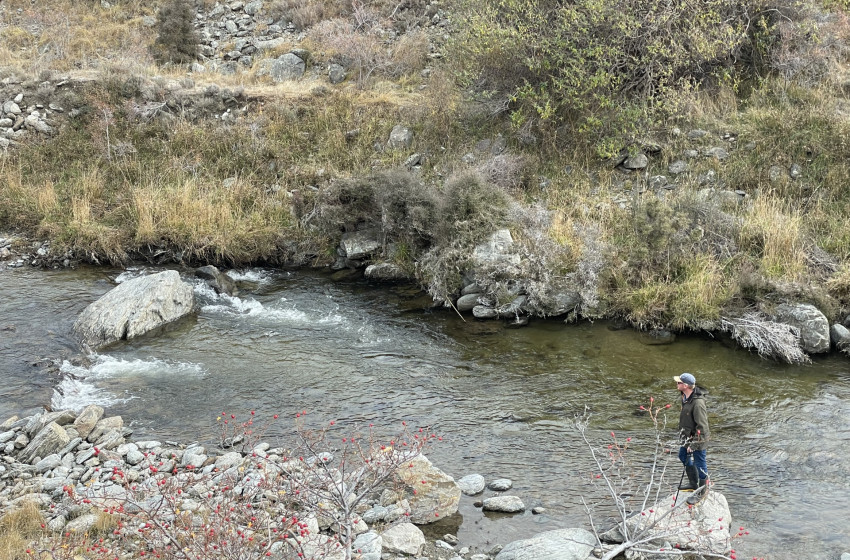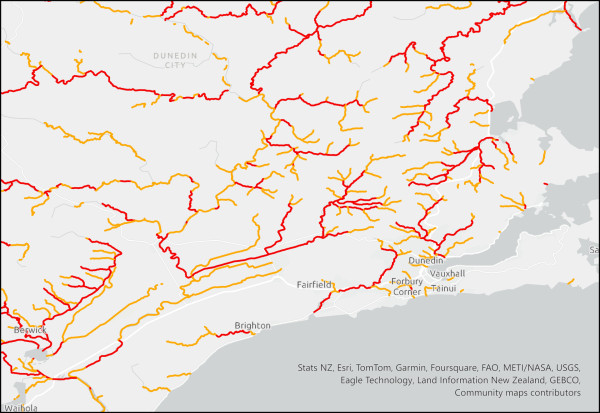New modelling sheds light on trout spawning
- Fishing Species management
- Otago
- 30/08/2024

New computer modelling is transforming understanding of where trout and salmon spawn in Otago after generations of riverbank legwork by Fish & Game officers.
The species distribution modelling predicts that 25% of river and stream lengths across the region are likely to sustain trout and salmon spawning.
Pictured above: Otago Fish & Game officer Ben Sowry conducts a brown trout spawning survey in Fraser River, Central Otago, in June 2024. Photo: Mason Court, Otago Fish & Game
“Before this model we would not have been able to put a number on the estimated range of spawning,” Otago Fish & Game officer Jayde Couper said.
“This model is a big step forward in our ability to monitor and manage critical trout and salmon habitats across Otago.
“Ground testing over last summer showed a high level of accuracy, and while not perfect, this model will improve as we gather more data. Now we have a very good idea where to look.”
The model is based on extensive datasets, including the Otago Fish & Game spawning database and the New Zealand Freshwater Fish Database.
It looks at habitat conditions which currently support spawning and then extrapolates to look for similar habitat conditions and each section of waterway on its likelihood of supporting spawning.
Staff will be able to double-check or update spawning area records dating back 50 years.
“The Otago trout fishery is internationally significant, drawing anglers from around the world, and it needs healthy and abundant spawning ground to flourish,” Mr Couper said.
“But due to the region’s extensive nature, it can be hard to identify the critical areas to protect.
“This model helps to narrow our focus to areas most likely to be important, allowing us to monitor and advocate for these waterways.”
Mr Couper said a better understanding of the likely extent of trout and the places where they spawn also helped Fish & Game to manage interactions between trout and native fish.
Otago Fish & Game Council has policy on species interactions that requires the organisation to work with other parties with statutory responsibilities for protecting native fish.
“Otago Fish & Game has no intention of increasing the extent of trout and believes that through habitat restoration and careful management, both native fish and valued introduced species can thrive,” Mr Couper said.
Otago Fish & Game staff carry out an average of 15 surveys per year to monitor spawning fish and their redds (nests).
“We have surveyed over 120km of river this year, almost 30km on foot with the remainder done with helicopters, funded by Contact Energy.
“The money from Contact means we can cover a lot more ground and allows us to accurately survey larger rivers like the Clutha/Mata-Au and Pomahaka.”
In addition to spawning surveys, Fish & Game uses electric fishing after the spawning period to find juvenile fish, which indicates successful spawning.
In Otago, brown trout and salmon spawning generally occurs in late autumn and early winter, while rainbow trout spawning takes place from late winter to spring.
A full report can be viewed on the Fish & Game website: 2024-Development-of-a-Salmonid-Spawning-Layer.pdf (fishandgame.org.nz)

An example of the spawning model in the Dunedin to Middlemarch area. The reaches have been color-coded: red indicates a high probability of being suitable spawning habitat, while yellow indicates a medium probability. It is estimated that the red sections will encompass approximately 60% of the suitable spawning reaches, with an additional 30% covered by the yellow sections.